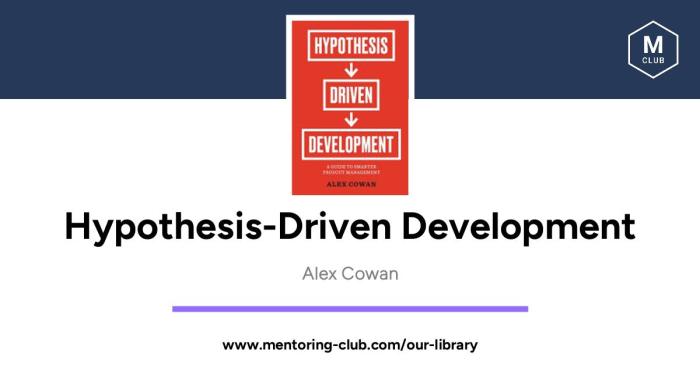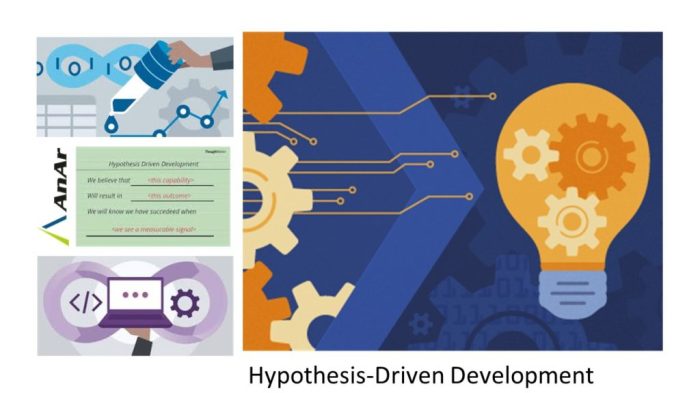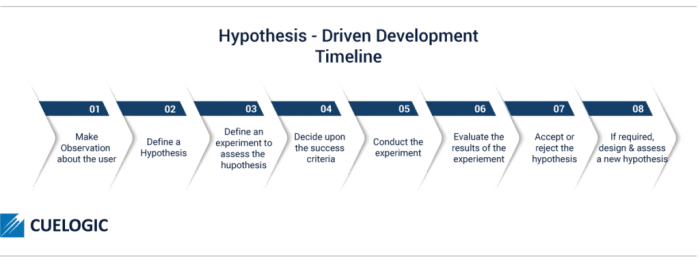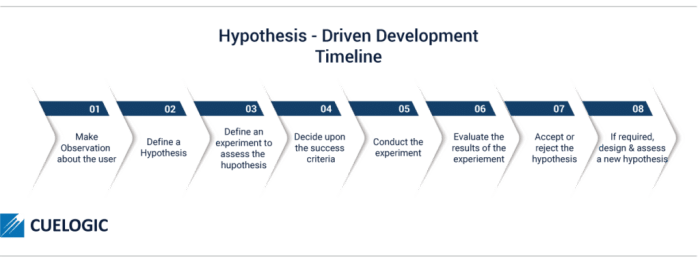Forget guesswork, product managers! It’s time to ditch the “build it and they will come” mentality and embrace the power of data-driven decisions. Hypothesis-Driven Development (HDD) is like having a crystal ball for your product roadmap, helping you make smarter choices and avoid building features nobody wants.
Think of it as the “Moneyball” of product management, where you’re not just relying on gut feeling but using a scientific approach to understand your users and build products that truly resonate.
This guide dives deep into the world of HDD, showing you how to leverage this powerful methodology to create winning products. From understanding the core principles to mastering the art of hypothesis testing, we’ll cover everything you need to know to transform your product management process.
The Fundamentals of Hypothesis-Driven Development
Think of it like this: You’re not just throwing spaghetti at the wall and seeing what sticks. Hypothesis-Driven Development (HDD) is about making smart, data-driven decisions in product management. It’s about understanding your users, formulating testable hypotheses, and then using data to validate or invalidate those hypotheses.
The Core Principles of Hypothesis-Driven Development
HDD is all about a scientific approach to product development. It’s about turning assumptions into testable hypotheses, then using data to validate or invalidate those hypotheses. This allows you to make informed decisions about your product, ensuring you’re building something that users actually want.
Comparison with Traditional Product Development Methodologies
HDD is different from traditional product development methodologies, which often rely on intuition and gut feeling. Traditional methods might involve lengthy product roadmaps, focusing on features instead of user needs. HDD, on the other hand, is more agile and data-driven, allowing you to adapt and pivot quickly based on user feedback.
Illustrating Hypothesis-Driven Development
Let’s imagine you’re building a new social media app for pet owners. You might start by formulating a hypothesis: “Pet owners are more likely to engage with the app if it includes a feature that allows them to share their pet’s daily activities.”You can then design an experiment to test this hypothesis, such as creating two versions of the appone with the feature and one without.
You could then track user engagement metrics like time spent on the app, number of posts shared, and overall app usage. If the data supports your hypothesis, you can confidently move forward with developing the feature. If not, you can iterate and explore alternative solutions.
Benefits of Hypothesis-Driven Development
- Reduced Risk:By testing hypotheses, you can avoid wasting time and resources on features that users don’t want. This is especially important in today’s competitive market, where time and resources are limited.
- Improved User Experience:By focusing on user needs and validating your assumptions, you can create a product that users actually love.
This can lead to increased engagement, higher retention rates, and ultimately, more success for your product.
- Faster Time to Market:HDD allows you to iterate and adapt quickly, leading to faster time to market. This is crucial in a world where new products and features are constantly being released.
Key Elements of Hypothesis-Driven Development
- User Research:Understanding your target audience is essential for formulating relevant hypotheses. Conduct user interviews, surveys, and usability testing to gather insights into their needs and pain points.
- Hypothesis Formulation:Turn your assumptions into testable hypotheses. Use a clear and concise format, such as “If we [action], then [outcome] because [reason].”
- Experiment Design:Carefully design experiments that will allow you to gather data and test your hypotheses.
Ensure your experiments are controlled and measure the right metrics.
- Data Analysis:Analyze the data you collect from your experiments to determine whether your hypotheses are supported or refuted. Use statistical methods to ensure the data is reliable and meaningful.
- Iteration and Adaptation:Based on the results of your experiments, iterate and adapt your product.
Don’t be afraid to pivot or abandon features that aren’t working.
Implementing Hypothesis-Driven Development

Okay, so you’ve got the basics of hypothesis-driven development down, but how do you actually put it into practice? This is where things get real, like trying to explain to your grandma how to use TikTok. Don’t worry, we’ll break it down step-by-step, with practical examples that’ll make you feel like a product management rockstar.
Implementing Hypothesis-Driven Development
It’s like building a rocket ship to the moon – you need a plan, the right tools, and a whole lot of teamwork. So, let’s dive into the steps to make this happen.
- Define Your Team’s Approach:First things first, you need to get everyone on the same page. This means defining your team’s approach to hypothesis-driven development, like establishing a shared understanding of the process, agreeing on key metrics, and deciding how you’ll prioritize experiments. Think of it like creating a band’s setlist – everyone needs to know their part to make the music awesome.
- Establish a Hypothesis Framework:This is like having a blueprint for your experiments. A good framework will help you define clear, testable hypotheses, like “Adding a live chat feature will increase customer engagement by 15%.” This structure helps you stay focused and ensures everyone’s on the same wavelength.
- Prioritize Hypotheses:You can’t test everything at once, so you need to prioritize your hypotheses based on their potential impact and feasibility. Think of it like choosing the most important ingredients for a cake – you want to start with the ones that will make the biggest difference.
Hypothesis-Driven Development is all about testing your assumptions, right? So, think of it like learning fingerstyle guitar. You start with a basic idea, like the “C” chord, and then you practice, practice, practice. But to really level up, you need to experiment with different techniques, like the ones in Fingerstyle For Noobs How to Decode & Progress With Fingerstyle Guitar in Under 23 Days 140 Exercises Included.
That’s what Hypothesis-Driven Development is all about – constantly testing and iterating to get the best results. Just like with guitar, the more you experiment, the better you’ll get!
- Design Experiments:Now it’s time to get creative! Design experiments that will test your hypotheses, like A/B testing, user surveys, or usability studies. Remember, the goal is to gather data that will prove or disprove your hypothesis, so make sure your experiments are designed to collect the right information.
It’s like setting up a science fair project – you need to make sure your experiment is controlled and measurable.
- Analyze Data and Iterate:Once you’ve gathered data from your experiments, it’s time to analyze it and draw conclusions. This is where you’ll see if your hypotheses were correct and learn from the results. It’s like reviewing your grades after a test – you want to understand what you did well and where you can improve.
Formulating Testable Hypotheses
Crafting a killer hypothesis is like writing a catchy song – it needs to be clear, concise, and attention-grabbing. Here’s how to make it happen:
- Identify a Problem or Opportunity:Start by pinpointing a specific problem or opportunity you want to address, like “Our website’s checkout process is too long and complex.” This is your starting point, like identifying the theme of your song.
- Develop a Solution:Brainstorm potential solutions to the problem or opportunity, like “Simplifying the checkout process by reducing the number of steps.” This is like coming up with the melody and lyrics for your song.
- Formulate a Testable Hypothesis:Now, combine your solution with a measurable outcome, like “Simplifying the checkout process by reducing the number of steps will increase conversion rates by 10%.” This is like writing the chorus of your song – it’s the core message that you’ll be testing.
Tools and Resources
You can’t build a house without tools, and the same goes for hypothesis-driven development. Here are some essential tools and resources that can help you:
| Tool/Resource | Description |
|---|---|
| A/B Testing Tools | These tools allow you to test different versions of your product or website to see which performs better. Examples include Optimizely, Google Optimize, and VWO. |
| User Research Tools | These tools help you gather insights from your users through surveys, interviews, and usability testing. Examples include UserTesting, SurveyMonkey, and Qualtrics. |
| Data Analytics Tools | These tools allow you to track and analyze data from your product or website to measure the success of your experiments. Examples include Google Analytics, Mixpanel, and Amplitude. |
| Project Management Tools | These tools help you organize and manage your experiments, from planning to execution and analysis. Examples include Asana, Trello, and Jira. |
Analyzing and Iterating on Hypotheses

Okay, so you’ve got your hypotheses, you’ve designed your experiments, and now it’s time to get your hands dirty. This is where the real magic happens. It’s time to analyze your results and see if your hypotheses are holding up.
Remember, this isn’t about being right or wrong, it’s about learning and adapting.
Conducting Experiments to Validate or Invalidate Hypotheses
It’s time to put your hypotheses to the test! We’re talking about real-world experiments, not just hypothetical scenarios. Think of it like a scientific experiment, but with a focus on your product. The goal is to gather data that can either confirm or deny your initial assumptions.Imagine you’re launching a new feature for your social media app.
Tired of building features that nobody wants? “Hypothesis-Driven Development: A Guide to Smarter Product Management” (Advanced Product Management Series) is your ultimate cheat sheet for building products that actually rock. Want to learn more? Download And Listen Here and level up your product management game.
With this guide, you’ll be crafting winning strategies and crushing your goals in no time!
You hypothesize that adding a “mood filter” will increase user engagement. To test this, you might run an A/B test. This involves creating two versions of the app: one with the mood filter and one without. You then randomly assign users to each group and track their engagement metrics over a set period.
If the group with the mood filter shows significantly higher engagement, you’ve validated your hypothesis. But if the engagement levels are similar, then you’ve got evidence to invalidate your hypothesis.
So, you’re thinking about getting your product management game on point, huh? Hypothesis-Driven Development A Guide to Smarter Product Management (Advanced Product Management Series) is the real deal, yo. It’s all about testing and learning, which reminds me of this epic story called The Castle AN ‘ORPHAN’ BOY’S STORY OF RESILIENCE AND LOVE IN XENIA OHIO , where this dude had to hustle and figure things out, just like you gotta do in product management.
Anyway, back to the book – it’s basically a guide to making sure your product’s a hit, and not just some random flop.
Metrics and Data Points to Track for Evaluating Hypothesis Performance
You can’t just throw a bunch of data at the wall and hope something sticks. You need to be strategic about the metrics you track. This is where the fun part comes inchoosing the right metrics to measure your hypothesis’s performance.
Think of it like choosing the right ingredients for a delicious recipe. You want to make sure you’re measuring what matters.Here’s a checklist of metrics and data points to keep in mind:
- Engagement metrics: These are the bread and butter of your analysis. They tell you how users are interacting with your product. Some examples include:
- Number of active users
- Time spent on the app
- Number of page views
- Click-through rates
- Conversion metrics: These metrics measure how successful your product is in achieving its goals. Think about what you want users to do with your product. Examples include:
- Number of sign-ups
- Number of purchases
- Number of subscriptions
- Retention metrics: These metrics show how well you’re keeping users engaged over time. It’s about keeping them coming back for more. Examples include:
- Number of returning users
- User churn rate
- Qualitative feedback: Don’t forget about the human element! Qualitative feedback can provide valuable insights that you might miss with just quantitative data. This can be gathered through user surveys, interviews, and focus groups.
Communicating Hypothesis Results to Stakeholders and Decision-Makers
You’ve got your data, you’ve analyzed it, and now it’s time to share your findings with the team. This is where your communication skills come into play. You need to present your results in a clear, concise, and compelling way.
- Tell a story: Don’t just throw numbers at them. Use visuals like charts and graphs to illustrate your points.
- Highlight the key takeaways: What are the most important things your stakeholders need to know?
- Be prepared to answer questions: Your stakeholders will likely have questions, so make sure you’re ready to address them.
- Don’t be afraid to admit when a hypothesis is invalidated: Remember, learning from your mistakes is a key part of hypothesis-driven development.
Book Review: Hypothesis-Driven Development: A Guide to Smarter Product Management
This book is a must-read for any product manager who wants to level up their game. It’s a practical guide to implementing a data-driven approach to product development, which is essential in today’s competitive market.
So you wanna level up your product management game, right? Hypothesis-Driven Development is like the secret sauce for making smart decisions. It’s all about testing your assumptions and figuring out what actually works. But, like, sometimes you gotta be able to explain it all in a way that’s clear and engaging.
That’s where the magic of voiceover comes in. Check out this awesome guide on finding your authentic commercial voiceover Authentic Commercial Voiceover Build Your Commercial VO Career by Finding Your Friendly Conversational Confident Voice – it’ll help you nail those product demos and presentations.
Once you’ve got that voice down, you’ll be slaying the product management world in no time.
Key Takeaways and Insights
The book’s core message is that product managers should stop guessing and start testing. This means developing hypotheses about user needs and product features, and then designing experiments to test those hypotheses. This process helps product managers make more informed decisions and avoid costly mistakes.
The book Artikels a framework for hypothesis-driven development, which includes defining the problem, developing a hypothesis, designing an experiment, analyzing the results, and iterating on the process.
Comparison with Other Methodologies
Hypothesis-driven development shares similarities with other methodologies like Agile and Lean Startup, but it has a distinct focus on testing and validating assumptions. Agile emphasizes iterative development and customer feedback, while Lean Startup focuses on building, measuring, and learning. Hypothesis-driven development complements these methodologies by providing a structured framework for testing assumptions and making data-driven decisions.
Target Audience and Value
This book is suitable for product managers at all levels of experience. It’s particularly valuable for those who are new to the field or looking to improve their product development process. The book provides a clear and concise framework for implementing hypothesis-driven development, along with practical examples and case studies.
Experienced product managers can benefit from the book’s insights on how to refine their existing processes and make data-driven decisions.
Concluding Remarks

By adopting HDD, you’re not just building products, you’re building a winning strategy. You’ll be able to validate your assumptions, identify hidden opportunities, and make data-driven decisions that drive real results. So, ditch the guesswork, embrace the power of HDD, and get ready to watch your product soar to new heights.
Top FAQs
What’s the biggest benefit of using Hypothesis-Driven Development?
HDD helps you avoid wasting time and resources on features that don’t resonate with your users. It’s like having a superpower that allows you to see into the future and understand what will work before you build it.
How can I get started with Hypothesis-Driven Development?
Start by defining a clear hypothesis for your product or feature. Then, design an experiment to test that hypothesis and gather data. Analyze the results, and use them to iterate and improve your product.
What are some common mistakes people make when using Hypothesis-Driven Development?
One common mistake is failing to define a clear and testable hypothesis. Another mistake is not collecting enough data to draw meaningful conclusions from your experiment. It’s also important to avoid confirmation bias and ensure that your experiments are designed to test your hypothesis, not simply confirm your existing beliefs.

